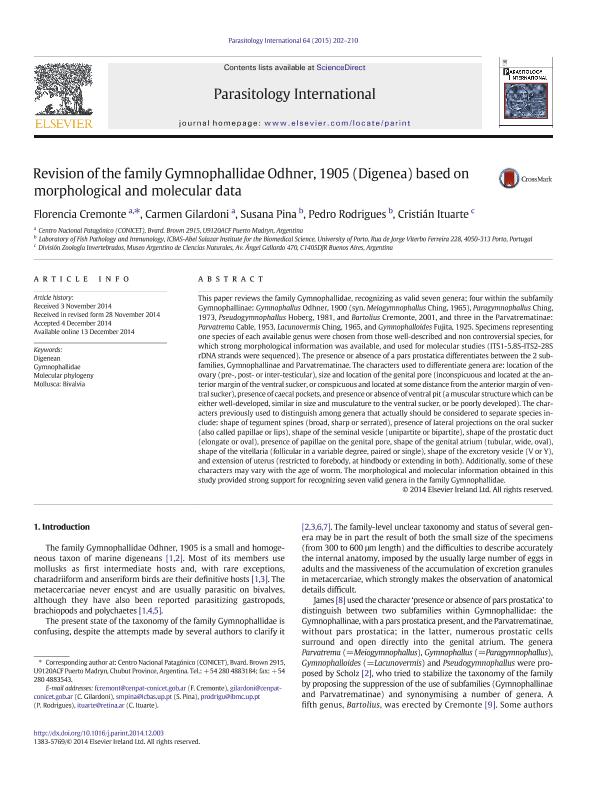Mostrar el registro sencillo del ítem
dc.contributor.author
Cremonte, Florencia

dc.contributor.author
Gilardoni, Carmen Mariangel

dc.contributor.author
Pina, Susana

dc.contributor.author
Rodrigues, Pedro

dc.contributor.author
Ituarte, Cristian Federico

dc.date.available
2017-06-29T21:40:50Z
dc.date.issued
2015-04
dc.identifier.citation
Cremonte, Florencia; Gilardoni, Carmen Mariangel; Pina, Susana; Rodrigues, Pedro; Ituarte, Cristian Federico; Revision of the family Gymnophallidae Odhner, 1905 (Digenea) based on morphological and molecular data; Elsevier Ireland; Parasitology International; 64; 2; 4-2015; 202-210
dc.identifier.issn
1383-5769
dc.identifier.uri
http://hdl.handle.net/11336/19236
dc.description.abstract
This paper reviews the family Gymnophallidae, recognizing as valid seven genera; four within the subfamily Gymnophallinae: Gymnophallus Odhner, 1900 (syn. Meiogymnophallus Ching, 1965), Paragymnophallus Ching, 1973, Pseudogymnophallus Hoberg, 1981, and Bartolius Cremonte, 2001, and three in the Parvatrematinae: Parvatrema Cable, 1953, Lacunovermis Ching, 1965, and Gymnophalloides Fujita, 1925. Specimens representing one species of each available genus were chosen from those well-described and non controversial species, for which strong morphological information was available, and used for molecular studies (ITS1-5.8S-ITS2-28S rDNA strands were sequenced). The presence or absence of a pars prostatica differentiates between the 2 subfamilies, Gymnophallinae and Parvatrematinae. The characters used to differentiate genera are: location of the ovary (pre-, post- or inter-testicular), size and location of the genital pore (inconspicuous and located at the anterior margin of the ventral sucker, or conspicuous and located at some distance from the anterior margin of ventral sucker), presence of caecal pockets, and presence or absence of ventral pit (a muscular structure which can be either well-developed, similar in size and musculature to the ventral sucker, or be poorly developed). The characters previously used to distinguish among genera that actually should be considered to separate species include: shape of tegument spines (broad, sharp or serrated), presence of lateral projections on the oral sucker (also called papillae or lips), shape of the seminal vesicle (unipartite or bipartite), shape of the prostatic duct (elongate or oval), presence of papillae on the genital pore, shape of the genital atrium (tubular, wide, oval), shape of the vitellaria (follicular in a variable degree, paired or single), shape of the excretory vesicle (V or Y), and extension of uterus (restricted to forebody, at hindbody or extending in both). Additionally, some of these characters may vary with the age of worm. The morphological and molecular information obtained in this study provided strong support for recognizing seven valid genera in the family Gymnophallidae.
dc.format
application/pdf
dc.language.iso
eng
dc.publisher
Elsevier Ireland

dc.rights
info:eu-repo/semantics/openAccess
dc.rights.uri
https://creativecommons.org/licenses/by-nc-nd/2.5/ar/
dc.subject
Digenean
dc.subject
Gymnophallidae
dc.subject
Molecular Phylogeny
dc.subject
Mollusca Bivalvia
dc.subject.classification
Zoología, Ornitología, Entomología, Etología

dc.subject.classification
Ciencias Biológicas

dc.subject.classification
CIENCIAS NATURALES Y EXACTAS

dc.title
Revision of the family Gymnophallidae Odhner, 1905 (Digenea) based on morphological and molecular data
dc.type
info:eu-repo/semantics/article
dc.type
info:ar-repo/semantics/artículo
dc.type
info:eu-repo/semantics/publishedVersion
dc.date.updated
2017-06-29T13:28:55Z
dc.journal.volume
64
dc.journal.number
2
dc.journal.pagination
202-210
dc.journal.pais
Irlanda

dc.description.fil
Fil: Cremonte, Florencia. Consejo Nacional de Investigaciones Científicas y Técnicas. Centro Científico Tecnológico Conicet - Centro Nacional Patagónico; Argentina
dc.description.fil
Fil: Gilardoni, Carmen Mariangel. Consejo Nacional de Investigaciones Científicas y Técnicas. Centro Científico Tecnológico Conicet - Centro Nacional Patagónico; Argentina
dc.description.fil
Fil: Pina, Susana. Universidad de Porto; Portugal
dc.description.fil
Fil: Rodrigues, Pedro. Universidad de Porto; Portugal
dc.description.fil
Fil: Ituarte, Cristian Federico. Consejo Nacional de Investigaciones Científicas y Técnicas. Oficina de Coordinación Administrativa Parque Centenario. Museo Argentino de Ciencias Naturales "Bernardino Rivadavia"; Argentina
dc.journal.title
Parasitology International

dc.relation.alternativeid
info:eu-repo/semantics/altIdentifier/doi/http://dx.doi.org/10.1016/j.parint.2014.12.003
dc.relation.alternativeid
info:eu-repo/semantics/altIdentifier/url/http://www.sciencedirect.com/science/article/pii/S1383576914001779
Archivos asociados
